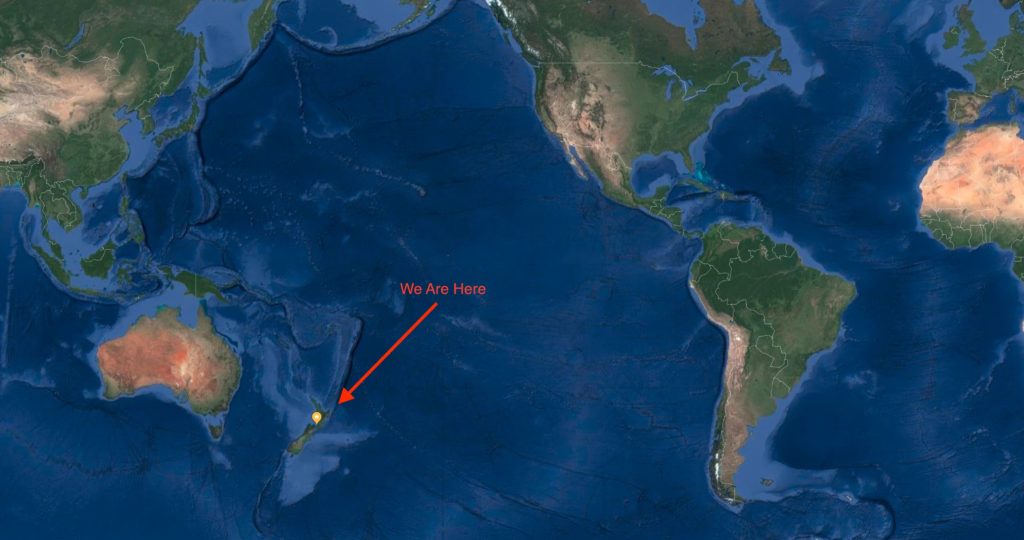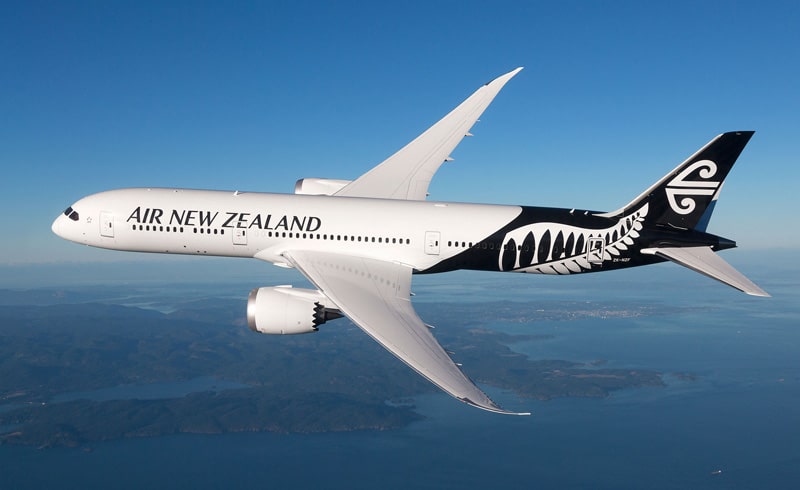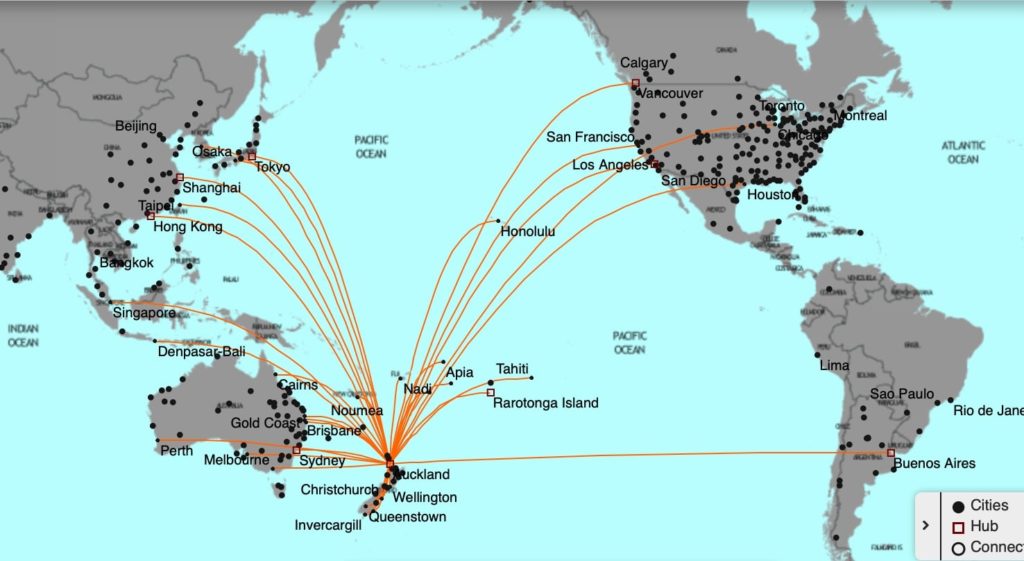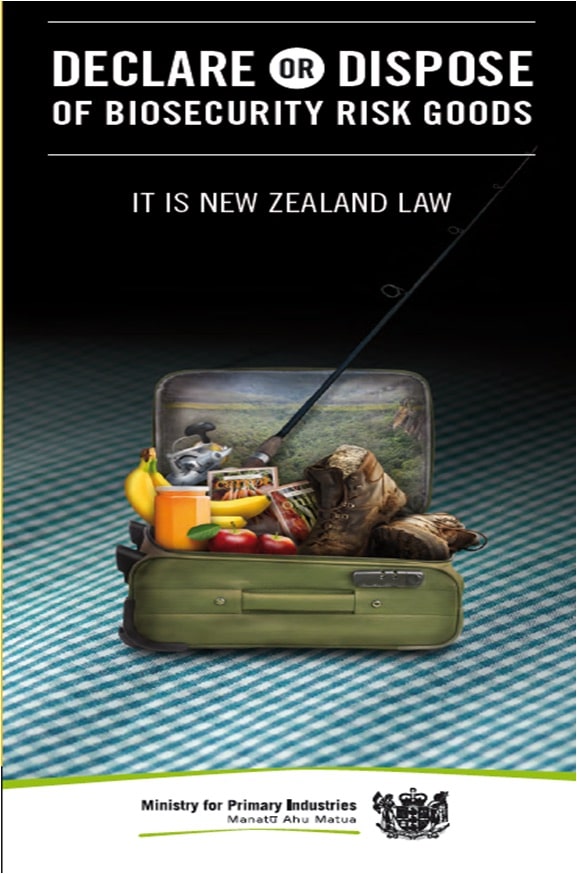
So you want to come visit us? Great! Here’s what you need to know.
The Essentials

Getting Here
New Zealand is about a 13 hour flight from the US West Coast. Air New Zealand (ANZ) and United are the major carriers for the US. We’ve only flown with Air New Zealand, so can’t really comment on the the others. Air NZ flies big planes, they have comfy seats, serve you dinner, breakfast, free wine, and heaps of entertainment (30+ movies to choose from). They also have the coolest safety video. Air NZ Bookings for US based flights can be made at the Air New Zealand website.

(Ir)Regardless ? of the airline you chose, the most likely US departure points will be either Los Angeles (13.5 hours), San Francisco (13.5 hours), Houston (15.3 hours) or Chicago (17 hours). Of course you can always book from another major city, say Boston, and the airlines will work with their partners in the US to schedule the appropriate connections and get your luggage transferred hassle free. Air NZ is part of the Star Alliance and its US airline partner is United Airlines.
All flights arriving from the US currently disembark in Auckland. Most flights arrive early morning, about a day and a half after you departed. So, if you depart SFO on a Saturday at 7:30pm, you will arrive in Auckland on the following Monday at around 5:30 AM. Don’t panic, you’ll get that missing day back on your return flight as you will depart NZ and arrive back in the US on the same day. Blame the international date line for the confusion.
Arrival Process
During your flight over to New Zealand, the cabin crew will have handed you a colourful Arrival card. Everyone must fill out a card. This is not a per family card like the US has. You can download a copy of the Passenger Arrival Card from the NZ Customs Service Website. You will need this card during the arrival process, so fill it out on the plane and keep it with your passport. Most of the questions on the arrival card are straightforward, but you will want to pay particular attention to Sections 5 which ask you about items that you have brought with you. More on this below…..
Passport Control
Upon arrival in Auckland you will proceed directly to Passport Control. eGates have been introduced frequently eliminating the need to queue at the Passport Control Desk and speak with a Immigration Officer. If you hold an e-passport from New Zealand, Australia, UK, US, Canada, France, Germany, China, Netherlands or Ireland you can proceed to the automated eGates.
The eGate kiosk reads your e-passport, asks you some simple questions, then issues you a ticket to use at the gate.
Insert your ticket at the gate, a camera will scan your face to see if it matches your passport. Take off anything that obstructs you face, like glasses. If you are successful, the gate will open! If not, usually due to a technical difficulty, see the Immigration officer at the desk.
If you are not eligible for eGate proceed to the Passport Control Desk where a nice Kiwi officer will ask you a few questions, check your arrival card and stamp your passport. There are two lines for Passport Control, one for Residents & Citizens and the other for Visitors. If you are reading this, you are a visitor.
After your passport has been stamped, the officer will give back your arrival card. Hang onto this as you will need it at biosecurity.
Baggage Claim
Next proceed to baggage claim and pick up your luggage. Note, even if you have had your luggage transferred to your end destination, you still have to pick up your luggage in Auckland. The friendly folks at Biosecurity want to take a look at what you’ve brought with you.
Biosecurity
One of New Zealand’s greatest assets is its relative geographical isolation. Less than 10% of the world’s pests and diseases occur in New Zealand. New Zealand has no poisonous snakes or spiders.
A major portion of our economy depends on maintaining the beauty of our natural environment. Just one new pest or disease could be devistating! Because our ecosystem is vulnerable to the officers at biosecurity will take the contents of your luggage very, very seriously.

Declare, Dispose or Pay
Section 5 of the arrival card covers Biosecurity and pretty much wants to know if you’ve brought any food, plants or animal products (packaged or otherwise). No, you don’t have to declare that stick of gum or box of tic tacs you have in your purse, but yes you have to declare the snickers bar or that banana you put in your carry-on luggage but forgot to eat. Did you bring some treats for the dogs? Declare them! Be sure to check your items to see if they contain ingredients things like egg or honey – including non-edible products. If so, declare the item. Biosecurity will also want to know if you’ve packed any items that might be used for camping, fishing, water sports, or with animals. Got a pair of water sandals? Declare them. A pair of hiking boots? Declare them! Some tennis shoes that you recently wore to the local county fair? Declare them. Did you bring a new dog collar or toy for Gromit? Declare it.
The key thing to remember is that most of what you are bringing into NZ is Ok and you will be allowed to keep them – Biosecurity just wants to ensure that the items don’t bring unintended consequences to our environment.
Heaps of information on the rules and processes at the NZ Biosecurity Website.
Some easy rules to follow:
- Don’t bring raw fruit. If you have a leftover item from the plane ride over, throw it out upon arrival.
- Only bring food that is still in it’s original, unopened package.
- Look at the ingredients of any food items you pack. If they contain meat, dairy, fish, honey, eggs, fruit, vegetables or nuts you will have to declare them. Depending on the ingredient, you may need to declare it as both a food product AND a plant product. Nuts fall into this category. See the arrival card for more details.
- Clean/brush all shoes before you pack them and be sure they are free of soil on the soles.
- Clean all camping and fishing gear before you pack.
- Make a list of all of the food and outdoor gear that you packed and keep it with you for reference when filling out the card. If you declare 9 items but forgot that you packed that box of Kraft Mac and Cheese, you will be fined for the omission. Getting it 90% right doesn’t count!
- If you are in doubt about a question or item, check “yes”.
Failure to declare an item will get you an on the spot $400 fine and can ultimately cost $100,000 or jail time. These guys don’t joke around.
Connecting Auckland to Wellington
Unless you are planning to stay a few days in Auckland, the next step in the process is to retreive your luggage and make it over to the Domestic terminal. The International and Domestic terminals are separated by a 15 minute walk or a 5 minute bus ride. As you exit biosecurity, check the local time and determine if you have an hour or more before your domestic flight. If you do, then take your luggage to the baggage drop. If you are flying with Air NZ it will be located on your right as you exit customs. The agent at the counter will take your luggage, and see to it that it makes it to your domestic flight. If you have less than an hour before your next flight, you will need to hand carry all of your luggage to the domestic terminal.
You have 2 options for getting to the domestic terminal:
- Walk. Simply follow the green line. Note, the walk is outdoors and not all of the path is covered, so check the weather first. It is also a 15 minute walk, so you should be in reasonable shape.
- Shuttle Bus. A shuttle bus runs between the international terminal and the domestic terminal every 20 minutes. It is located outside of door 6/7.
- If you are unsure, just ask one of the locals. I’ve never met a Kiwi who wasn’t helpful and, unlike the folks at LAX with big smiles sporting badges that say “airport courtesy clerks”, the local Kiwi won’t hit you up for a donation.
- Once you arrive at the Domestic terminal, you will either proceed directly to your departure gate, or, if you still have your luggage, you will need to head to check in to deposit your luggage and pick up your boarding card. If you are running late and miss your connecting flight, don’t panic, head directly to the Domestic terminal checkin desk and they will book you on the next outbound flight. Flights to Wellington from Auckland run about every 30 minutes. I’ve missed my connection flight several times and it has never been a big drama to get on the next flight.
When Should you visit?
New Zealand is the land of opposites. The seasons in New Zealand are flipped with Summer runs from December to February. The weather gets cooler as you head South and warmer as you head North. January and February are the warmest months of the year and July is the coldest. Generally speaking, the best time to travel here is November thru April.
New Zealand’s average rainfall is high and evenly spread throughout the year, although winter tends to be the wettest. Despite the high rainfall, most places in New Zealand receive over 2000 hours of sunshine a year.
Unlike most continental climates, New Zealand does not have a large termperature range. The termperature rarely dips below freezing or sneeks into the 80’s. Despite the moderate temperature range, the sun is very intense. The sunshine combined with relatively low pollution levels make for a dangerous UV index. SPF30 is mandatory attire for visitors to New Zealander , as is a big floppy hat to protect the most vulnerable parts of your face. Ignore the warning and trust me, you will get burned!
Windy Welly
Wellington’s meteorological trademark is wind. Wellington is located next to the Cook Strait – the corridor that runs between the North and South Islands. As a result, Wellington averages 173 days a year with wind gusts greater than 60 km/r (~37mph) and gales relatively clock in with gust of over 140km/h (~87mph).
Holidays and Planning
New Zealanders get 4 weeks of vacation and most take two of those weeks around the Christmas holiday. If you plan to come around Christmas there are two things to consider
- Bookings go quickly. You should plan to book accomodations or activities well in advance of your holiday. In many cases, you may need 4-6 months notice.
- Many smaller restaurants, bars and shops, particularly in the suburbs may be closed at this time.
Attire – four seasons in one day
Although New Zealand had a moderate climate, the weather can change unexpectedly as cold fronts or tropical winds quickly blow in.
A casual, late afternoon walk can start out sunny but leave you drenched by an unexpected downpour.
So, to sum things up we have sun, but unexpected downpours, moderate temperatures but a high UV index, and wind that will knock you off of your feet. How should you pack for your trip? The best advice we can give is to plan on dressing in layers. Your day may start in shorts and a t-shirt, but by late afternoon you’ll want a fleece jacket or jumper (NZ-speak for sweater) to throw on. Footwear should focus on comfort over style. Leave the Jimmy Choo Leaopard print pony shoes at home and pack the Teva’s and walking sneakers instead.
Here’s a short list of must pack items
- hat – preferably one with a large brim
- SPF 30 lotion
- walking sneakers
- comfortable sandals – preferably waterproof for beach walks
- medium weight jacket – light weight polar fleece is perfect
- waterproof jacket
- medium weight sweater or sweatshirt
- t-shirts, long and short sleeve
- shorts and jeans
New Zealand does have stores selling anything you forgot, so don’t stress about packing. You can always help our economy by making a purchase locally.
Accomodations
Wellington
While in Wellington, you are welcome to stay with us at our home in Southgate. We currently have a spare bedroom with a double bed an ocean view and access to the deck. The house is conveniently located a short distance from Wellington’s city center an easy 15 minute bus ride in, or if you are game, a 50 minute walk.
Outside of Wellington
Of course if you are coming to New Zealand, you will want to travel beyond Wellington to get a real taste for the beauty of this country.
Hotels and Motels
While most of the major cities have larger hotels, the majority of accommodations are Mom and Pop run motels. These are usually your best bet. A room for two will cost between $150-$200 (NZ) a night and most include a small kitchen for making tea/coffee and simple meals. These motels are very good at accommodating families by providing rooms for 3 and 4 people. When booking a room, be sure to check the type of bed. Many hotels have “twins or twin share” which are great for two people who are traveling together but prefer not to share sleeping arrangements. Double rooms usually have a queen or double bed. There are two online sites where you can peruse the accommodations that are available in the area: Jasons and AA. Most places take credit cards. Many have refundable deposits if your plans change, but make sure to check this first if you think your plans are uncertain. Note, the AA site usually has a non-refundable fee for booking, but in many cases the motel can be booked directly and the fee can be avoided.
Youth and Backpacker Hostels
If economy is your goal, a good option is to book rooms at youth hostels. Don’t let the name put you off. Most hostels have a wide selection of room types from private rooms to shared “bunk” rooms. The rooms will be basic, but comfortable. Many hostels have private rooms with an ensuite bathrooms available. The rest of the facilities are shared: common kitchens, bathrooms and lounges. The communal kitchens are well equipped with everything you need to cook your meal except the food. For more information, go the YHA site.